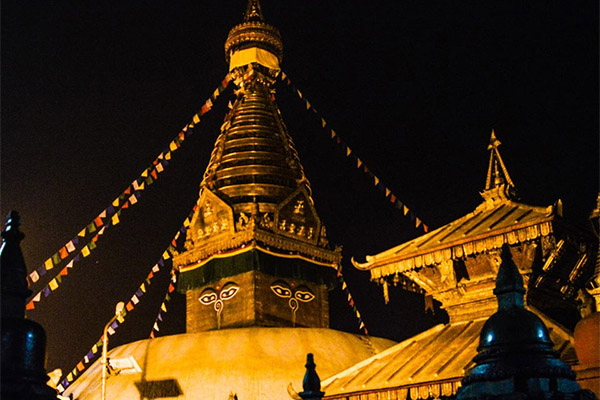
History of Swoyambhu Temple – Kathmandu Nepal
There is belief that if swoyambhunath does not exist, Kathmandu won’t exist.

Swoyambhunath is the oldest religious sites famous for both Buddhist and Hindus in the Kathmandu Valley, located west of Kathmandu city.
The story of origin of Swayambhu Chaitya is the starting point in the history of the origin of Buddhism in Nepal.
According to the story depicted in the Swayambhu Purana – the Swayambhu is self-originated from an eternal light in a
lotus flower grown in the lake in Kathmandu Valley called the Naghrada.
Swayambhu Purana, tells of a miraculous lotus, planted by a Vipaswi Buddha, which blossomed from the lake that once covered Kathmandu valley.
At present, there is a Chaitya at the top of the hill which is a popular sacred destination for Nepalese as well as the Tibetan Buddhists.
The lotus mysteriously radiated a brilliant light, and the name of the place came to be Swayambhu, meaning ‘Self-Created or Self-Existent’. Saints, sages and divinities traveled to the lake to venerate this miraculous light for its power in granting enlightenment.
Emerge of Maha Manjushir

During this time, the Bodhisattva Manjushri was meditating at the sacred mountain of Wu Tai Shan and had a vision of the dazzling Swayambhu light.
6. Manjushri flew across the mountains of China and Tibet upon his blue lion to worship the lotus. Deeply impressed by the power of the radiant light
Manjushri felt that if the water were drained out of the lake Swayambhu would become more easily accessible to human pilgrims. With a great sword Manjushri cut a gorge in the mountains surrounding the lake.
As the water escaped, several naags and other animals living in it went out, but he persuaded Karkotaka to stay in taudhaha, He created lakes named Taudaha, Dhanadaha and Dwadasha Tirtha, where those serpents who had been dwelling in the lake in the valley could take shelter.
The water, draining away, left the valley of present-day Kathmandu. The lotus was then transformed into a hill and the light became the Swoyambhunath Stupa.
Each morning before dawn, hundreds of pilgrims will ascend the 365 steps that lead up the hill
On each of the four sides of the main stupa there are a pair of big eyes. These eyes are symbolic of God’s all-seeing perspective.
There is no nose between the eyes but rather a representation of the number one in the Nepali alphabet, signifying that the single way to enlightenment is through the Buddhist path.
Above each pair of eyes is another eye, the third eye, signifying the wisdom of looking within. No ears are shown because it is said the Buddha is not interested in hearing prayers in praise of him.
Harati, the Goddess of smallpox and other epidemics. The presence of the Harati Devi temple signifies the intermingling of the pantheons of Hinduism and Buddhism in the development of the religious trends of Nepal. As Buddhists had no deity in their own pantheon to protect against the dreaded smallpox, they adopted the Hindu deity for assistance.
Shantikar Acharya Tantric – Shantipur

A top Swoyambhunath hill is another fascinating, though smaller and less visited temple. This is Shantipur, the ‘Place of Peace’, inside of which, in a secret, always locked, underground chamber lives the 8th century Tantric master Shantikar Acharya. Practicing meditation techniques which have preserved his life for uncounted centuries, he is a great magician who has complete power over the weather. When the valley of Kathmandu is threatened by drought, the King of Nepal must enter the underground chamber to get a secret mandala from Shantikar. Soon after the mandala is brought outside and shown to the sky, rain begins to fall.
In 1658, King Pratap Malla descended into the chamber alone to seek Shantikar’s help with a drought. The king reported making his way through several underground rooms, each more frightening than the last. The first contained large bats and hawks, the second was home to hungry ghosts that clutched at him in agony, and the third was full of snakes that chased him until he pacified them with milk. The king found the saint in the last room, skinny as a skeleton but still alive and meditating for 1500 Years. Shanti Shri presented the king with a mandala, which brought the needed rain in the valley.
The small temple has a powerful atmosphere; it is mysterious, stern and slightly ominous.
From the above mentioned evidence of the influence of Swoyambhunath on society through customs, rituals, architecture and even in Hindu temples, it is clear that the people of Nepal have an unbounded faith in Swayambhu.